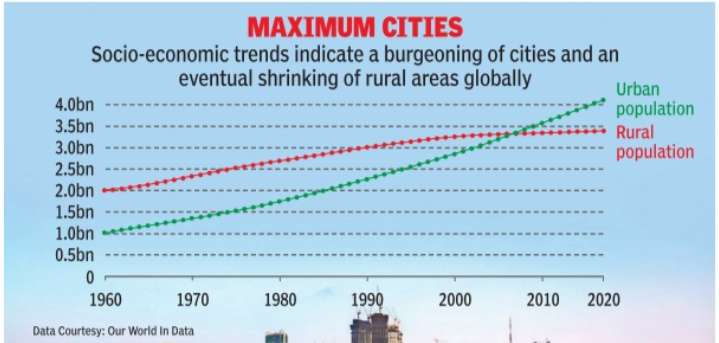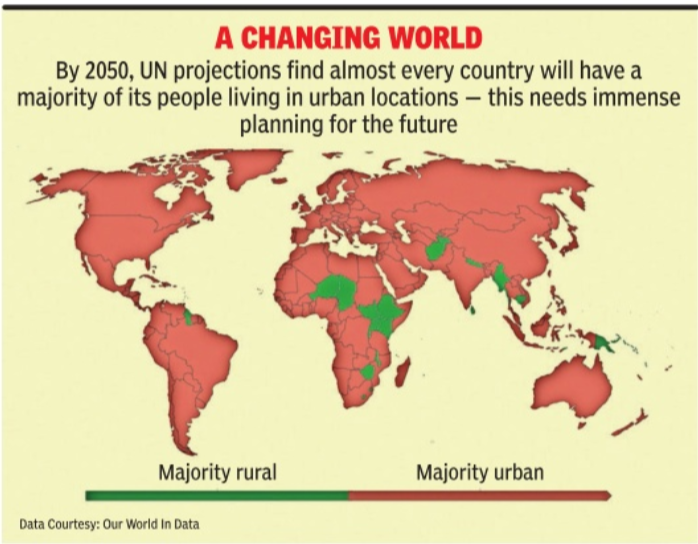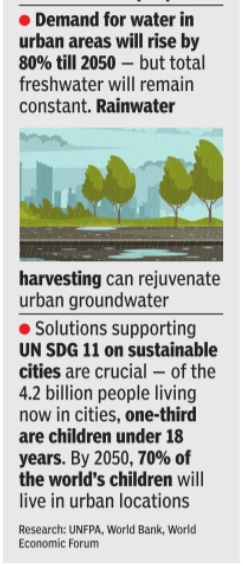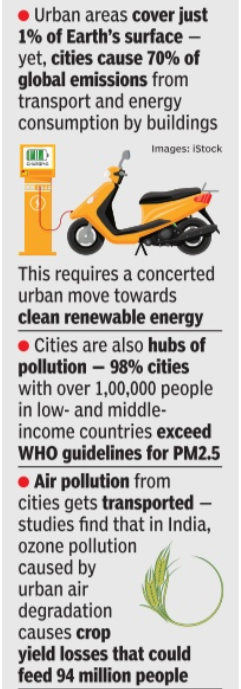ForumIAS announcing GS Foundation Program for UPSC CSE 2025-26 from 19 April. Click Here for more information.
ForumIAS Answer Writing Focus Group (AWFG) for Mains 2024 commencing from 24th June 2024. The Entrance Test for the program will be held on 28th April 2024 at 9 AM. To know more about the program visit: https://forumias.com/blog/awfg2024
Contents
- 1 Introduction
- 2 Why is the present model of Urbanisation not sustainable?
- 3 Why are poor countries or poor section of people more vulnerable to the impacts of urbanisation?
- 4 What is a sustainable city? And what are the factors that facilitate a completely sustainable city?
- 5 Why does the world need sustainable cities?
- 6 What should be done to promote sustainable cities?
| For 7PM Editorial Archives click HERE → |
Introduction
The World has been undergoing rapid urbanisation. The United Nations Population Fund (UNFPA) estimates that 4. 2 billion people or 55% of the world’s population lives in cities. By 2030, this will be over 5 billion. 68% of the world will be urban by 2050. Cities are economic powerhouses — they contribute over 80% of the gross national product worldwide. But the Urbanisation in the present world is lacking in concepts like sustainable cities.
Why is the present model of Urbanisation not sustainable?

At present, most countries of the world including developing countries follow the urbanisation models of the West which are based on low population densities spread over large amounts of land. This is a sustainable model in the West because of low population levels. However the same model can’t be replicated in the developing countries because of large population pressure. In most of the cities in the developing world there are large well endowed enclaves which are modelled on cities in the West e.g., Lutyens in Delhi. These enclaves are not sustainable. As an illustration, the water use in Lutyens is 400 litres per capita while it is only 30 litres on the outskirts of Delhi. Most of this water is sourced from outside. This disparity within cities is not sustainable in the long run. Same argument extends for other urban services like traffic management (wide roads in enclaves, and congestion in other areas).
Moreover cities in the developing world have their own local challenges. They are situated in tropical climates (high temperature, high rainfall regions) and are vulnerable to different disasters (like flooding due to cyclones), distinct from cities in the West (mostly Temperate climate). Consequently, cities in the developing world need different solutions based on locally available resources.
| Read more: Urban governance and urban floods: Storm warnings of a megacity collapse |
Why are poor countries or poor section of people more vulnerable to the impacts of urbanisation?
The vulnerability of the poor countries to natural disasters is much larger due to a) The global north-south divide of cities: The political and economic power of cities to advance sustainability measures are very different in developing vs developed world. Developed countries have greater capacity to address sustainability because there is more public and private sector investment in sustainable solutions like in building operations, transport firms, etc., b) Location of poor people at the global level: More poor people live in areas that are more vulnerable to climate change like the equatorial belt which has witnessed greater increase in temperature and frequency of cyclones, c) Poor people work mostly in agriculture or occupations that tend to be more climate-sensitive like outdoor jobs, manual labour etc. They lack the capacity to adapt.
What is a sustainable city? And what are the factors that facilitate a completely sustainable city?
According to United Nations World Economic and Social Survey 2013, a sustainable city has the following characteristics: 1) They should meet their inhabitant’s development needs without imposing unsustainable demands on local or global natural resources and systems. 2) They should not transfer risk both spatially and temporarily. 3) They should integrate socio-economic development, environmental management, and urban governance. 4) The settlements should be inclusive, safe, resilient and sustainable.
| Read more: Launch of Smart cities and Academia Towards Action & Research (SAAR) |
Few factors that facilitate a sustainable city include 1. Good governance — this needs participation by people amid a framing of equality and justice, 2. Building a sustainable city involves a framework of ethics: This is because the politics and governance of cities are informed by the political cycle. People are in power for a certain number of years, and they often make decisions based on this timeline. But the ethics of a truly sustainable city requires a more expanded temporal vision. 3. Creating a sustainable city is not just a technical or scientific exercise — this process involves everyone living in a city. 4. Alongside, there must also be thought about future generations. A sustainable city must have an understanding of whether it is thinking about future generations in the contemporary way it is responding to sustainability.
Why does the world need sustainable cities?

Impact of climate change: Building climate resilience is among the most important aspects of a city’s life. Cities are massive contributors to climate change — but the worst impacts of climate change will also be borne by cities.
Climate change also impacts the urban socio-economy. The UN finds 2.9 billion people live in cities where income inequality is more pronounced than it was one generation ago. If not managed in time, the city could transform into a place of embodying vulnerability, inequity and instability.
| Read more: Why India needs ‘good’ urbanisation |
Demand for energy: UN-Habitat finds cities consume two-thirds of the world’s energy and generate 75% of global carbon emissions. Just 25 cities cause 52% of urban greenhouse gas emissions through electricity generation, transport and industry. This intensifies pollution within cities: WHO finds over 80% of people in urban areas face unsafe air quality. Worryingly, India has 43 of the world’s 100 most environmentally risky cities.

More climate migration to cities: The UN estimates one in seven people on Earth is already a migrant. As climate change makes farming less viable, migration to cities will grow. Over one billion people worldwide live in slums — by 2030, one in four could reside thus. India is also witnessing climate migration in cities, where more people live in unauthorised areas.

Inability of present systems to address the complexity of urbanisation: Every city is growing around its edges but owing to the lag in data, there are issues in pollution, garbage management and sewage. By the time the city planners understand this occurrence, the complexity of the numbers is beyond their control. For instance, there are massive numbers of urban commute between Delhi and Gurugram, because there is no housing for them in the city.
Cities for elite and Day Zero threat cities: Cape Town had a Day Zero in 2018 when it practically ran out of water. Similarly, Chennai suffers from water scarcity — yet, every time it rains, Chennai is flooded, largely because, the city destroyed its amazing water systems like the Buckingham Canal, the Cooum river, etc. This is true for the majority of urban development in the world.
| Read more: Azadi@75 Star Rating Protocol of Garbage Free Cities- Toolkit 2022: MoHUA launches roadmap to make Urban India ‘Garbage Free’ |
What should be done to promote sustainable cities?

Inclusive planning with diversity: Urban planning has to include all the future issues including the last-mile connectivity issues, support more mixed traffic, mixed housing, walkable areas, etc.
Climate change will bring more extreme rain events. So, cities face huge flooding risks. Alongside, Indian cities need water. So, India should begin local water harvesting and increase urban sponges like green areas, lakes, ponds and wetlands. This will provide multiple benefits. Such as 1. Reduce long-distance water transfers, which are extremely expensive and break the back of every city’s water utility, 2. Green areas bring down the temperature, thereby reducing the urban heat island effect.
Need to rethink the western concept of cities: The western model of cities concepts needs rethinking because of their resource and energy intensity. City structures use huge amount of energy because of their design like the use of glass facades which increases need for air-conditioning. Modern Urban housing has to use the principles of passive architecture. This means building with nature and not against it. Thermal comfort at affordable prices needs urban design using passive architecture as opposed to more unsustainable glass facades with double-insulation, etc.
| Note: The traditional architecture of India planned for the sun. Every home, for instance, had chajjas or visors to protect against the sun’s rays. Such buildings brought down the temperature substantially. Historically, Indian urban planning respected ecology — Jaisalmer was built according to the sun, and it harvested every drop of rain it received. It built courtyards, wind channels, water tanks and many innovations enabling sustainability. |
Improve public service utilities and amenities to low-income migratory population: The government can provide a safety net. For instance, providing basic medical care and more efficiently matched markets between workers and employers in construction, etc.
Implement welfare schemes: The government can also implement schemes that demotivate urban migration. For example, due to the MGNREGA scheme, families are not migrating to urban locations. The same is applicable to the Mexican government’s cash transfer plans and their outcomes. Many social safety net programs have been started globally during the pandemic — these should be expanded in an era of climate change.
| Read more: India needs smart urbanisation |
Climate resilience measures within cities can reshape urban life with empathy and equity. Hence, the world needs to move towards sustainable cities.




